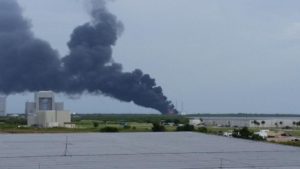A SpaceX Falcon 9 Booster exploded on the pad at Cape Canaveral Air Force Station Launch Complex 40 today, minutes before a standard test of the first stage engines in anticipation of a scheduled launch on Saturday, September 3rd. Of course, this explosion destroyed the booster vehicle and the payload, the AMOS-6 satellite which was intended to provide broadband internet access to parts of sub-Saharan Africa. It can also be assumed, as with any on-the-pad explosion, that the infrastructure at Launch Complex 40 has been damaged and will be in need of repairs.
For a better understanding of this event, let’s take a look at the Falcon9 and pre-flight testing.
The Falcon 9 is comprised of 2 stages – basically, 2 separate, complete rockets stacked on one another. The 1st stage, the one that was to be test fired, is comprised of 9 engines, designed to push the upper stage into an altitude, and give it enough velocity to do it’s job. The 2nd stage, with one engine designed for high altitude and vacuum operation, is designed to put the payload, in this example the AMOS-6 satellite, into its desired orbit.
In this test, the vehicle was being fueled as if it was ready for a flight, to test everything on the booster and make sure it would be good to go for its flight Saturday – while only the first stage would be test fired, the second stage was also fueled, to ensure all those systems would work properly.
As the video shows, sometime during this fueling and testing, there is an explosion in the second (upper) stage. The official report is that the anomaly, as they are calling it, occurred near the upper stage liquid oxygen tank. You can see in the video that the upper stage explodes, then begins to seemingly rain flame down into the lower stage – this would be the RP-1 (purified Kerosene) fuel spilling down, resulting in the eventual explosion of the fully fueled 1st stage. You can actually see what looks like the payload itself crashing into the flames as the booster finally falls apart, and the connections on the support tower, which provided fuel, liquid oxygen, and electrical connections to the Falcon9 rocket, are decimated as a result of the blast.
This goes to show that while most launches go flawlessly, there is minimal room for error with rocketry.
https://en.wikipedia.org/wiki/Falcon_9
Update on this morning's anomaly pic.twitter.com/1ogCMPCY44
— SpaceX (@SpaceX) September 1, 2016



From what I’ve read building a rocket is like making a super complex domino course and accidentally knocking one over because literally any problem with the rocket could turn into a huge one.
That’s about right. If something critical fails, the whole thing is probably lost. There are many failure modes that are “safe” (like the loss of an engine on the 1st stage) but if anything just blows like that, it’s all over.